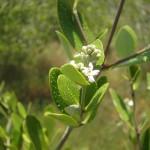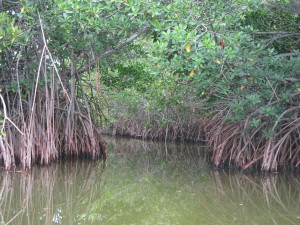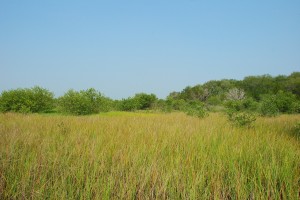by Dan Gruner

Black mangrove. Mangroves like this tolerate hot, salty environments partly by exuding excess salt onto their leaves. (John Parker)
I don’t think anyone believes that will happen. However, it does seem that mangroves are moving up in latitude, encroaching into more temperate salt marsh systems dominated by cord grass and other herbaceous species. Although mangrove systems are in steep decline worldwide because of coastal development, aquaculture and other human activities, climate change and other factors may be increasing their total geographic range.
Why would this happen? What would this mean for coastal ecosystems in the USA and globally? And what would it mean for the billions of people who live within 20 miles of a coastal zone, or the billions more who rely on some form of oceanic protein?
In collaborative research between the Smithsonian Environmental Research Center and the University of Maryland, we aim to find out. Combining field studies with satellite and aerial imagery, we will document this pattern more extensively, test hypotheses for its causes, and explore the consequences for ecosystem services provided by critically important coastal wetlands.
This summer, we’ll send dispatches from numerous field sites along a 210-km stretch of the Florida eastern coast. This coastal stretch is an “ecotone”, or a transition zone between two distinct biomes. Along the Indian River Lagoon estuary – the most biologically diverse in the USA – and points further north, we see an extent of habitat that grades from pure mangrove to pure salt marsh, with a range of mixtures along the way. Luckily for our team, we can work out of two premier laboratories on either end of the ecotone – the Smithsonian Marine Station in Fort Pierce in the South, and the Guana Tolomato Matanzas National Estuarine Research Reserve (GTM NERR) near St. Augustine in the North.

Red mangrove stand. As the climate warms, habitats like this could replace cord grass salt marshes. What will this mean for the organisms that live there? (John Parker)
High salinity is phytotoxic – excess salt concentrations crystallize proteins within plant cells and kill them without mercy or exception. Plant roots also do not like prolonged inundation because cellular respiration requires oxygen that is quickly used up underwater. In essence, salts dehydrate plant cells and the flooding water suffocates them. Not exactly your paradise on earth?
Mangroves are a grab bag of 70-plus woody shrub and tree species from at least 16 families of plants worldwide. These species are grouped together not by their relatedness but by their physiological niche and ecological function. These species share the ability to tolerate inundation of their roots with salt water. It turns out they will grow just fine in freshwater wetlands, but they achieve their competitive advantage via their diverse adaptations to increase oxygen supply to their roots and to exclude, excrete, or tolerate higher salt levels.

Salt marsh. These black mangroves seem to be happily growing among cord grass and saltwort. (John Parker)
Climate change, writ large, is the most likely explanation for recent expansions of mangroves into salt marshes. However, this explanation may include a huge range of possible mechanisms that must be tested with data. These include strictly abiotic hypotheses: warmer air or water temperatures, less frequent or less severe cold snaps, changes in precipitation, sea level rise…and they include changes in biotic interactions, such as altered relationships with competitors, pollinators, herbivores or decomposers. Other human-caused changes—nutrient or chemical eutrophication, land use change, fisheries—may interact with climatic drivers to cause complex outcomes.
With our research we hope to uncover some answers to these questions. Stay tuned as we develop this research and send out natural history notes from this most fascinating of ecosystems.
More stories from the mangroves
Dan Gruner is an ecologist at the University of Maryland and co-investigator for the mangrove project. This material is based upon work supported by the National Science Foundation under Grant Number 1065098. Any opinions, findings, and conclusions or recommendations expressed in this material are those of the author(s) and do not necessarily reflect the views of the National Science Foundation.


I am a graduate student in architecture at Tulane in NOLA, with an interest in plants as landbuilders. I want to know more about mangroves and where to acquire seeds and plants.